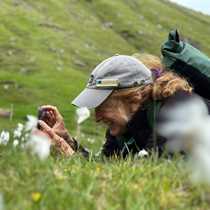Isla San Ildefonso & Punta Pulpito
When we prepare for our travels and explorations, many of us pack a camera along with an assortment of other gear and gadgets. The technology of capturing and sharing images has changed dramatically in the past few years. Some cameras may seem frustratingly complex, with a multitude of knobs and buttons illustrated with a variety of little tiny icons. With a few simple instructions, the icons become prompts as to the proper settings for a variety of images we want to capture and share.
When you travel with Lindblad Expeditions, you are invited to “Explore the Possibilities,” these possibilities can be varied and seemingly endless, as we have found this past week in Baja California. The diverse prospects, discoveries and sightings also dictate the need for a new set of icons on our cameras. Here are some proposals for a Baja California customized Lindblad dial on your camera: The leaping dolphin icon, so you can capture the exuberance and energy of a sleek, shiny, momentarily airborne dolphin. The cardon cactus icon, a large format landscape feature that assists the photographer in capturing the immensity of this stoic multi-armed behemoth against a shimmering-blue sea backdrop. The big-eyed fish icon, a submersible camera feature allowing you to take images underwater as you snorkel waters abundantly filled with colorful fish and unusual invertebrates. The whale icon, a panoramic feature which facilitates fitting the full expansive length of a fin whale, or sperm whale into your viewfinder.
There are some sightings which you might not be sure of what the proper camera icon setting should be to capture the image most effectively. We experienced this dilemma today. When the whale shark showed up during our Zodiac cruises at Isla San Ildefonso we may have had to decide between the fish icon and the whale icon. Or when we were later surrounded by pilot whales, we might have found ourselves torn between using the dolphin icon or the whale icon. These images could quickly come into focus using our Lindblad “eye of discovery” icon. With this setting there would be no question as to where your focus should be, your captured memories would automatically be sharp and perfectly framed. And with our National Geographic alliance and their development of geo-referencing technology, your guesswork would become history while your memories are put on the map.
We’ve spent the week unearthing the treasures of Baja California, and we’ve found quite a few gems. With our proposed new camera “icons” the opportunities to capture and share these jewels will be unlimited, and with that we continue to invite you to “Explore the Possibilities.”
When we prepare for our travels and explorations, many of us pack a camera along with an assortment of other gear and gadgets. The technology of capturing and sharing images has changed dramatically in the past few years. Some cameras may seem frustratingly complex, with a multitude of knobs and buttons illustrated with a variety of little tiny icons. With a few simple instructions, the icons become prompts as to the proper settings for a variety of images we want to capture and share.
When you travel with Lindblad Expeditions, you are invited to “Explore the Possibilities,” these possibilities can be varied and seemingly endless, as we have found this past week in Baja California. The diverse prospects, discoveries and sightings also dictate the need for a new set of icons on our cameras. Here are some proposals for a Baja California customized Lindblad dial on your camera: The leaping dolphin icon, so you can capture the exuberance and energy of a sleek, shiny, momentarily airborne dolphin. The cardon cactus icon, a large format landscape feature that assists the photographer in capturing the immensity of this stoic multi-armed behemoth against a shimmering-blue sea backdrop. The big-eyed fish icon, a submersible camera feature allowing you to take images underwater as you snorkel waters abundantly filled with colorful fish and unusual invertebrates. The whale icon, a panoramic feature which facilitates fitting the full expansive length of a fin whale, or sperm whale into your viewfinder.
There are some sightings which you might not be sure of what the proper camera icon setting should be to capture the image most effectively. We experienced this dilemma today. When the whale shark showed up during our Zodiac cruises at Isla San Ildefonso we may have had to decide between the fish icon and the whale icon. Or when we were later surrounded by pilot whales, we might have found ourselves torn between using the dolphin icon or the whale icon. These images could quickly come into focus using our Lindblad “eye of discovery” icon. With this setting there would be no question as to where your focus should be, your captured memories would automatically be sharp and perfectly framed. And with our National Geographic alliance and their development of geo-referencing technology, your guesswork would become history while your memories are put on the map.
We’ve spent the week unearthing the treasures of Baja California, and we’ve found quite a few gems. With our proposed new camera “icons” the opportunities to capture and share these jewels will be unlimited, and with that we continue to invite you to “Explore the Possibilities.”




